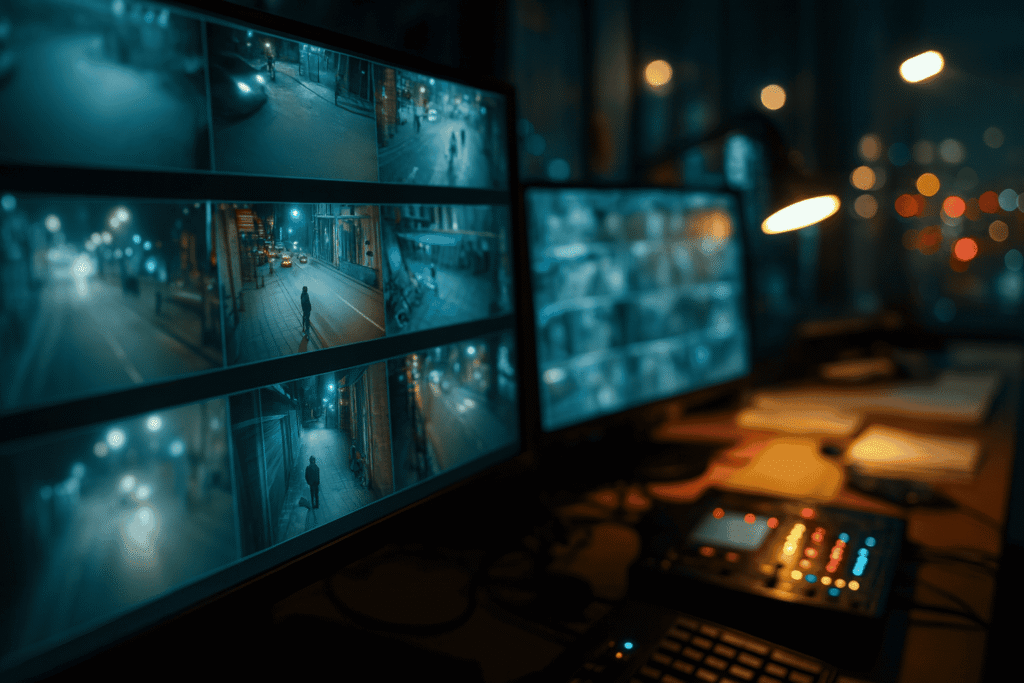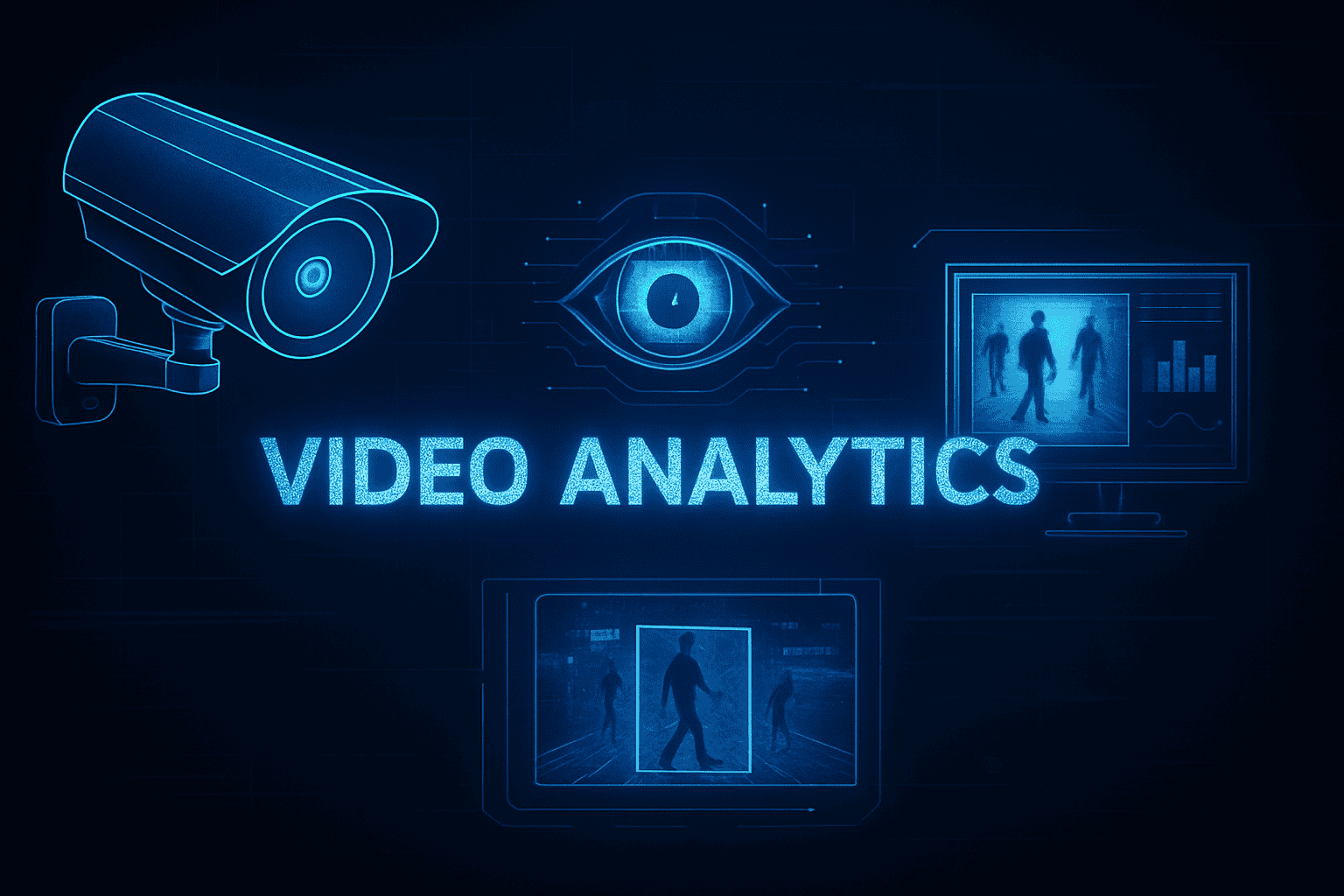Computer vision and AI video analytics are among the fastest-growing technologies in recent years. Computers, which once had significant problems analyzing images and videos, are beginning to understand better and better what they see, and generate specific data, alerts, and recommendations. In 2025, computer vision solutions increasingly serve as active tools for managing processes, security, efficiency, and quality.
In 2025, the ecosystem of companies creating video analysis technologies can be divided into four main groups:
- CCTV equipment manufacturers with dedicated VMS platform
- Third-party platforms and universal VMS + AI software
- Developer tools for building your own solution
- End-to-End Custom AI Video Analytics Providers
Below is the overview of companies from each of these categories – along with their strengths and relevant applications.
1. CCTV equipment manufacturers with dedicated VMS platform
This group is dominated by brands such as Axis, Bosch, Hikvision, Avigilon, and Dahua, which have been producing professional IP cameras for years and developing their own video management systems (VMS). Their solutions form the foundation of many surveillance installations – both in the public and private sectors.
Axis Communications, a Swedish pioneer in the production of IP cameras, is known for its high image quality, hardware reliability, and open ecosystem ACAP (Axis Camera Application Platform). ACAP enables the installation of external AI applications directly on cameras1. Axis is often used in smart cities, education, and commercial facilities.
Bosch Security Systems offers exceptionally advanced edge analytics that can recognize objects, count them, analyze direction and speed of movement even in difficult conditions – e.g., in strong sunlight, rain, or industrial environments. Their cameras are often installed in critical infrastructure (airports, energy, heavy industry), where reliability and data quality matter.
Hikvision, the world’s largest manufacturer of CCTV equipment, offers a wide catalog of equipment – from IP cameras, through recorders, to the comprehensive HikCentral platform, which combines monitoring, access control, and basic AI analytics (face recognition, license plate recognition, intruder detection)2. The company has a strong presence in the physical security sector, public administration, and large commercial facilities.
Avigilon (owned by Motorola Solutions) specializes in end-to-end systems integrated with very high-resolution cameras. Their solutions are often used in the security sector, defense, as well as in large corporations. Avigilon’s strong point is Appearance Search™ technology, enabling instant search for specific people or vehicles across multiple cameras simultaneously.
Dahua Technology, similar to Hikvision, offers affordable but comprehensive monitoring systems that integrate with their own VMS and AI analytics (e.g., mask detection, body temperature, perimeter alarms). The brand is widely used in commercial facilities, logistics, and healthcare.
CCTV hardware manufacturers with dedicated VMS provide a solid technological foundation for surveillance and video analytics installations. Their solutions are integrated hardware and software-wise, offering good performance, basic analytics, and ease of deployment within one ecosystem. They work best in areas such as physical security, visual surveillance, facility monitoring, and access control. However, their limitation is lower flexibility and difficulty in adapting to advanced, custom applications – e.g., in production process analysis, logistics, or operational optimization, where independent systems or end-to-end providers work better.

2. Third-party platforms and universal VMS + AI software
The second market group consists of producers of independent VMS (Video Management System) platforms and software for more advanced video analytics, which operate independently of specific camera manufacturers. These systems provide greater flexibility, the ability to integrate with various video sources and external AI modules, making them often chosen by medium and large organizations with complex operational needs. Key players in this category are Milestone Systems, Genetec, and Irisity.
Milestone Systems, owned by Canon Group, is the creator of one of the most popular open VMS platforms – XProtect. This system is known for high scalability, security, and the ability to integrate with almost any IP camera brand and external analytical solutions (e.g., AI for object recognition, face recognition, incident detection)3. XProtect is often used for large scale projects such as city systems, airports, and industrial complexes.
Genetec, a Canadian leader in integrated security systems, offers the Security Center platform, which combines video management, access control, and analytical modules. Genetec strongly emphasizes cybersecurity, GDPR compliance, and permissions management – making their solutions particularly popular in public institutions, banking, universities, and public transport sector. The company also offers its own video analysis tools – including KiwiVision – for perimeter protection, people counting, and unauthorized access detection4.
Irisity, a Swedish technology company, develops software for intelligent real-time image analysis, focusing on advanced functions for detecting intruders, sabotage, aggression, and other security incidents. Their system works both in the cloud and locally, and can be integrated with any IP cameras. Irisity uses its own artificial intelligence and machine learning algorithms to enable automatic detection of unusual events without the need for continuous operator supervision. Their solutions are used in education, logistics, energy, and perimeter protection sectors – wherever quick incident response is critical.
Independent VMS platforms with analytical software, such as Milestone, Genetec, and Irisity, offer a higher level of flexibility and interoperability. They are a good choice for organizations that have complex camera infrastructure or need to combine monitoring with other security, logistics, traffic management, or data analysis systems. While they don’t always provide ready industry solutions, they form a solid foundation for developing modern, automated surveillance and video analytics systems.
3. Development tools for building your own solution
The third key group in the video analytics market consists of providers of developer platforms and tools that enable companies to build their own custom systems based on computer vision. These solutions are used by systems integrators, R&D teams, technology startups, as well as large enterprises implementing their own products in the areas of industrial IoT, automation, or visual inspection. Leading players in this category include: NVIDIA (Metropolis), Amazon Rekognition, Merlic (MVTec), VXG, and Roboflow.
NVIDIA Metropolis is a comprehensive ecosystem for creating, training, and deploying AI and video-based applications. It includes hardware platforms like Jetson, streaming processing libraries (DeepStream SDK), transfer learning tools (TAO Toolkit), and ready-made Computer Vision models. Metropolis enables building applications that run locally (edge) or in the cloud, providing high performance and easy scalability. It is used in industry, retail, smart cities, and security systems.
Amazon Rekognition is a cloud service within AWS, offering ready-made image and video analysis functions available through API. It enables face recognition, object detection, text identification, emotion analysis, content safety assessment (e.g., detecting nudity, violence), and video motion analysis.
Merlic, developed by German company MVTec, is a no-code/low-code tool for creating visual applications – mainly for industrial visual inspection needs. Unlike AI frameworks, Merlic doesn’t require programming – users create image analysis processes using a graphical interface. Merlic contains ready-made functions for edge detection, element measurement, defect identification, and presence control. It is used among others by visual systems integrators.
VXG is a modern platform enabling video processing and streaming in the cloud or on edge, with ready API for AI and SaaS integrators. The system supports multiple protocols (RTSP, WebRTC, HLS) and enables connecting video streams to any AI models – running locally, in the cloud, or on Docker containers. VXG stands out for its deployment speed and flexibility – it’s often chosen by companies building their own products with monitoring, analytics, or remote supervision functions.
Roboflow is a platform popular among startups and teams prototyping their own computer vision models. It enables quick data labeling, model training (YOLO, EfficientDet, TensorFlow, CoreML, and others), testing, and deployment – in mobile applications, on edge, or in the cloud.
Developer tools such as NVIDIA Metropolis, Amazon Rekognition, Merlic, VXG, and Roboflow allow building custom, case-specific solutions based on computer vision – from simple mobile applications to complex industrial systems. This is an ideal choice for companies that have a technical team, integrator, or need maximum flexibility. Such solutions provide full control over functionality but require more time, knowledge, and testing. For many organizations, however, they form the foundation for creating unique products and technological advantages in the market.
4. End-to-End Custom AI Video Analytics Providers
The fourth and simultaneously most results-oriented group consists of companies offering complete, ready-to-deploy AI video analytics systems, designed from start to finish to solve specific operational, industry, or business problems. Unlike VMS providers or AI frameworks, companies in this group don’t offer “do-everything” tools – only tailored, contextual solutions running on ready AI models, often integrating camera imagery with additional systems (ERP, MES, WMS, SCADA). Such providers include Vidiana, Spot.ai, Actuate, and Trigo.
Vidiana is a European provider of video analytics AI systems aimed primarily at manufacturing and logistics companies. The platform can work with existing CCTV camera infrastructure and uses computer vision models for analyzing production line and manual workstation efficiency, signaling downtime, or monitoring compliance with safety regulations. The ability to deploy this solution without stopping processes, flexible scalability, and quick integration (including with external software like ERP) are just some of the advantages. Vidiana targets companies that need a ready tool to increase efficiency and operational control.
Spot.ai is an American company that redefines how organizations use camera recordings – offering a platform for searching and analyzing video as easily as using Google search. Their system allows users to instantly find specific people, events, or situations across multiple cameras – without needing to review hours of recordings. Spot.ai integrates AI analytics (e.g., object detection, people counting, face recognition) with an accessible interface, making it particularly attractive for companies in retail, office, education, and services sectors that don’t have time or teams to operate advanced CCTV systems.
Actuate is a provider specializing in using AI to ensure physical security in public and commercial spaces. Their software runs on existing cameras and serves to automatically detect firearms, intrusions, fights, camera sabotage, or unauthorized gatherings, without needing to recognize people’s identities. Actuate strongly emphasizes compliance with privacy principles (privacy-by-design) and application in sectors such as schools, offices, government buildings, and university campuses, where rapid threat detection can save lives.
Trigo is an Israeli startup developing computer vision systems for autonomous stores and retail. Their solutions enable creating “grab & go” stores where customers can enter, take products from shelves, and leave without scanning – while the system automatically registers what was purchased. Their analytics also allow tracking consumer behavior, analyzing movement paths, and optimizing product placement.
End-to-end providers such as Vidiana represent the most business-outcome-oriented approach. They don’t provide “do-everything” platforms, but ready systems that can be deployed quickly, without an AI team, without creating custom models, and without advanced technical integration. Their solutions focus on specific industries – from increasing production efficiency, through improving security, to complete store automation. In a world of rising labor costs, pressure for automation and process digitization, these types of providers are becoming a real alternative to classic VMS.
Summary: How to Navigate across the Video Analytics Market?
The video analytics market in 2025 has reached a new level of maturity. On one hand, computer vision technology has become widely available, on the other – the number of available solutions, tools, and providers can be overwhelming. Therefore, it’s crucial to understand who offers what and for whom – because differences between various provider groups are significant.
Choosing the right provider doesn’t depend only on budget or number of cameras – but primarily on what problem you want to solve. Do you only need monitoring? Do you want to measure production efficiency? Or is your goal public safety or retail transformation?
The video analytics AI market in 2025 already provides not just choice – it gives strategic advantage to those who can match appropriate tools to their processes.

